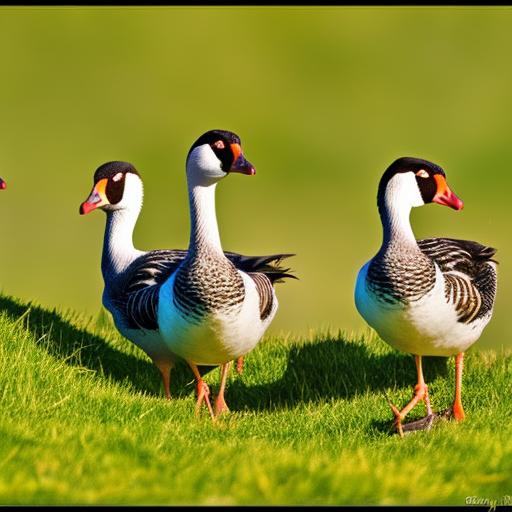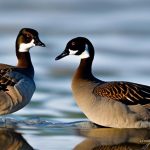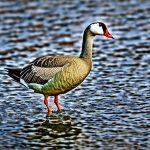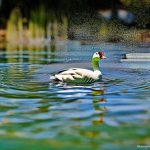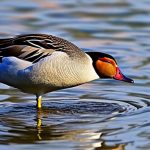Geese are beautiful creatures that are often found near bodies of water, such as ponds, lakes, and rivers. While they can be a delight to watch, they can also cause significant damage to grassy areas. Geese are herbivores and their diet consists mainly of grass, which means that they can quickly strip an area of its lush greenery. This can be a major problem for parks, golf courses, and other public spaces where maintaining a well-manicured lawn is important.
The presence of geese on grassy areas can also lead to other issues, such as an increase in fecal matter. Geese are known to produce a large amount of droppings, which can not only be unsightly but also pose health risks to humans and other animals. Additionally, the constant grazing and trampling of grass by geese can lead to soil erosion and compaction, further damaging the landscape. It is important for property owners and managers to find effective ways to deter geese from these areas in order to preserve the beauty and functionality of the grassy spaces.
Key Takeaways
- Geese can cause damage to grass areas through overgrazing and droppings, leading to unsightly and unhealthy conditions.
- Natural deterrents such as planting tall grasses, using predator decoys, and applying repellent sprays can help keep geese away from grass areas.
- Physical barriers like fences, netting, and hedges can effectively prevent geese from accessing and damaging grass areas.
- Technology such as sound devices, lasers, and motion-activated sprinklers can be used to scare off geese from grass areas.
- Creating an unfriendly environment for geese by removing food sources, reducing water access, and maintaining a clean and well-kept landscape can discourage geese from staying in the area.
- Professional services such as wildlife management companies and landscape architects can provide expertise in designing and implementing geese management strategies for grass areas.
- Long-term strategies for managing geese on grass areas include habitat modification, population control, and ongoing maintenance of deterrents and barriers to prevent geese from returning.
Natural deterrents for geese
One of the most environmentally friendly ways to deter geese from grassy areas is by using natural deterrents. There are several plants and shrubs that are known to repel geese due to their strong scent or taste. For example, tall grasses such as switchgrass and big bluestem can create an inhospitable environment for geese, as they prefer shorter, more tender grasses. Additionally, planting shrubs with thorny or prickly foliage, such as holly or barberry, can discourage geese from grazing in these areas.
Another natural deterrent for geese is the use of certain essential oils, such as grape seed extract or citrus oils. These oils can be sprayed onto the grass to create a scent that is unpleasant to geese, causing them to seek out other feeding grounds. It is important to note that while natural deterrents can be effective, they may require regular reapplication and maintenance in order to remain effective. Property owners should also consider the potential impact of these deterrents on other wildlife and the surrounding ecosystem before implementing them.
Physical barriers to keep geese off grass
Physical barriers can be an effective way to keep geese off grassy areas. One common method is the installation of fencing around the perimeter of the grassy space. This can be particularly effective for smaller areas, such as gardens or courtyards, where geese may be more easily contained. The height and material of the fence are important considerations, as geese are capable of flying over low fences and may be able to knock down flimsy barriers.
Another physical barrier option is the use of netting or bird spikes. Netting can be installed over grassy areas to prevent geese from accessing the space, while bird spikes can be placed on flat surfaces, such as ledges or rooftops, to discourage geese from landing. These methods are non-invasive and can be effective in deterring geese without causing harm to the birds.
Using technology to deter geese
Advancements in technology have led to the development of various devices that can be used to deter geese from grassy areas. One popular option is the use of sound deterrents, such as sonic repellers or distress calls. These devices emit sounds that are unpleasant to geese and can effectively discourage them from staying in the area. It is important to note that sound deterrents should be used sparingly and in accordance with local noise ordinances.
Another technological solution for deterring geese is the use of visual deterrents, such as predator decoys or reflective tape. Predator decoys, such as fake coyotes or owls, can create the illusion of danger for geese, causing them to avoid the area. Reflective tape can also be effective in deterring geese by creating a visual disturbance that makes them feel uneasy. These methods can be particularly useful for open spaces where other deterrent options may not be feasible.
Creating an unfriendly environment for geese
In addition to using natural and technological deterrents, property owners can take steps to create an unfriendly environment for geese in order to discourage them from frequenting grassy areas. One effective method is to modify the landscape by adding features that make it difficult for geese to access the space. For example, creating steep slopes or adding rocks and boulders around the perimeter of the grassy area can make it less appealing for geese to land and graze.
Another way to create an unfriendly environment for geese is by reducing access to water sources. Geese are attracted to areas with water, so limiting their access to ponds or lakes near grassy areas can help deter them from congregating in these spaces. This can be achieved by installing fencing or barriers around water features or using floating barriers on the water’s surface to prevent geese from landing.
Working with professional services to keep geese away
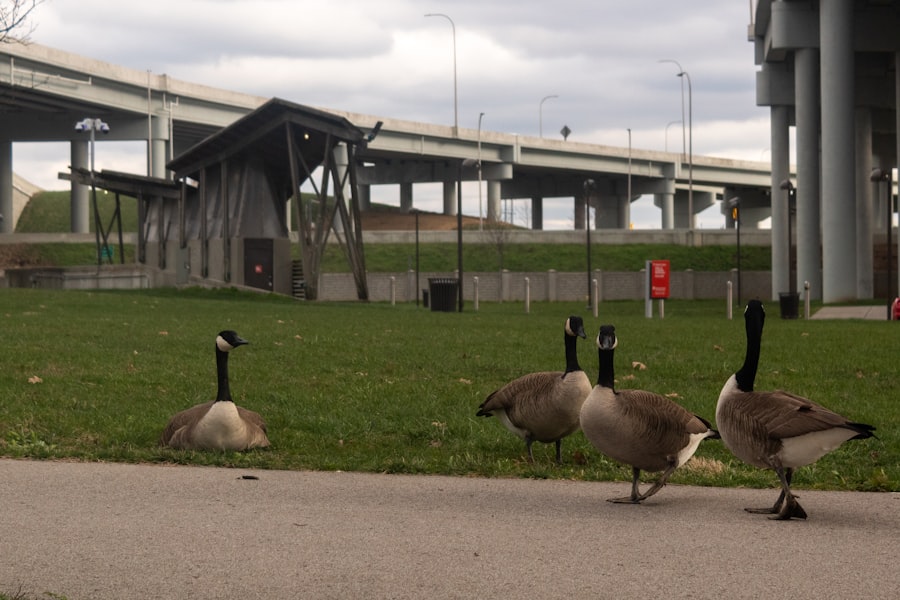
For property owners who are struggling to manage geese on their grassy areas, working with professional wildlife management services can be a valuable solution. These services often have expertise in dealing with geese-related issues and can provide a range of options for deterring geese from grassy spaces. Professional wildlife management services may offer services such as habitat modification, population control measures, and ongoing maintenance to keep geese away.
In addition to providing practical solutions for deterring geese, professional services can also offer guidance on local regulations and best practices for managing wildlife on private property. This can be particularly helpful for property owners who are dealing with legal or ethical considerations related to deterring geese from their grassy areas. By working with professionals, property owners can ensure that they are implementing effective and humane strategies for managing geese.
Long-term strategies for managing geese on grass areas
In order to effectively manage geese on grassy areas in the long term, property owners should consider implementing a combination of strategies that address both the immediate presence of geese and the underlying factors that attract them to these spaces. This may include ongoing maintenance of natural deterrents, regular monitoring of physical barriers, and periodic adjustments to technological deterrents.
Long-term strategies for managing geese on grassy areas should also include efforts to educate the public about the importance of coexisting with wildlife in urban environments. This may involve providing information about the ecological role of geese and promoting responsible behavior around these animals. By fostering a greater understanding of wildlife among community members, property owners can work towards creating a more harmonious relationship between people and geese in shared spaces.
In conclusion, managing geese on grassy areas requires a multifaceted approach that takes into account the behavior of geese, the needs of the landscape, and the concerns of property owners. By implementing a combination of natural deterrents, physical barriers, technological solutions, and long-term strategies, property owners can effectively deter geese from damaging grassy areas while promoting a healthy coexistence with wildlife. Working with professional services and engaging with the community can further support efforts to manage geese in a sustainable and responsible manner.
If you’re looking for effective ways to keep geese off your grass, you might also be interested in learning about the benefits of chicken coop portage. This innovative method not only helps in managing the impact of geese on your grass but also provides a sustainable solution for maintaining a healthy environment for your poultry. To find out more about this technique, check out the article on poultrywizard.com.
FAQs
What are some effective methods to keep geese off grass?
Some effective methods to keep geese off grass include using physical barriers such as fences or netting, using visual deterrents such as scarecrows or reflective tape, and using sound deterrents such as noise-making devices.
Are there any natural deterrents that can be used to keep geese off grass?
Yes, there are natural deterrents that can be used to keep geese off grass. These include planting tall grasses or shrubs around the perimeter of the grass area, using natural predators such as dogs or birds of prey, and applying non-toxic repellents such as grape seed extract or garlic spray.
What are some potential drawbacks of using chemical deterrents to keep geese off grass?
Some potential drawbacks of using chemical deterrents to keep geese off grass include the risk of harming other wildlife or pets, the potential for environmental contamination, and the need for regular reapplication of the deterrent.
How can I prevent geese from returning to the grass area after using deterrents?
To prevent geese from returning to the grass area after using deterrents, it is important to consistently and regularly apply the chosen method of deterrence. Additionally, it may be helpful to make the grass area less attractive to geese by removing sources of food or water, and by keeping the area well-maintained and free of debris.
Meet Walter, the feathered-friend fanatic of Florida! Nestled in the sunshine state, Walter struts through life with his feathered companions, clucking his way to happiness. With a coop that’s fancier than a five-star hotel, he’s the Don Juan of the chicken world. When he’s not teaching his hens to do the cha-cha, you’ll find him in a heated debate with his prized rooster, Sir Clucks-a-Lot. Walter’s poultry passion is no yolk; he’s the sunny-side-up guy you never knew you needed in your flock of friends!

